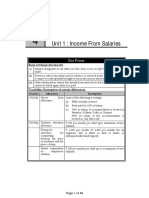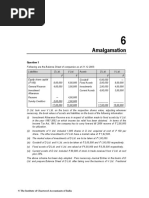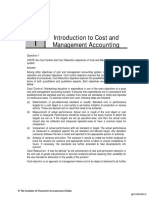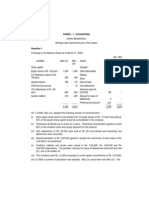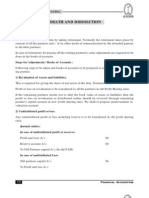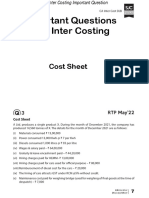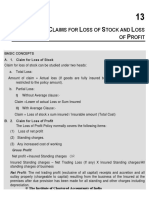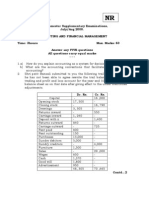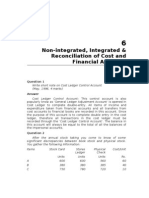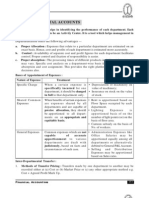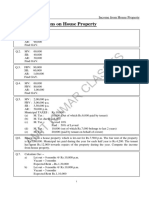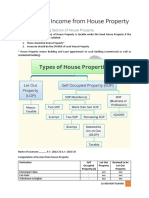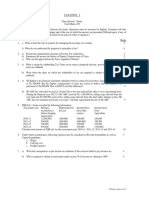Ca Inter - Nov 2018 - Advanced Accounts - Suggested Answers PDF
Uploaded by
HIMANSHU NCopyright:
Available Formats
Ca Inter - Nov 2018 - Advanced Accounts - Suggested Answers PDF
Uploaded by
HIMANSHU NOriginal Title
Copyright
Available Formats
Share this document
Did you find this document useful?
Is this content inappropriate?
Copyright:
Available Formats
Ca Inter - Nov 2018 - Advanced Accounts - Suggested Answers PDF
Uploaded by
HIMANSHU NCopyright:
Available Formats
PAPER – 5: ADVANCED ACCOUNTING
Question No.1 is compulsory.
Candidates are also required to answer any four questions from the remaining five questions.
Working notes should form part of the respective answers.
Wherever necessary, candidates are permitted to make suitable assumptions which should be
disclosed by way of a note.
Question 1
Answer the following questions:
(a) From the following information given by Sampark Ltd., Calculate Basis EPS and Diluted
EPS as per AS 20 :
`
Net Profit for the current year 2,50,00,000
No. of Equity Shares Outstanding 50,00,000
No. of 12% convertible debentures of `100 each 50,000
Each debenture is convertible into 8 Equity Shares
Interest expense for the current year 6,00,000
Tax saving relating to interest expense (30%) 1,80,000
(b) On 1st April, 2018, Tina Ltd. take over the business of Rina Ltd. and discharged purchase
consideration as follows:
(i) Issued 50,000 fully paid Equity shares of ` 10 each at a premium of ` 5 per share to
the equity shareholders of Rina Ltd.
(ii) Cash payment of ` 50,000 was made to equity shareholders of Rina Ltd.
(iii) Issued 2,000 fully paid 12% Preference shares of ` 100 each at par to discharge the
preference shareholders of Rina Ltd.
(iv) Debentures of Rina Ltd. (` 1,20,000) will be converted into equal number and amount
of 10% debentures of Tina Ltd.
Calculate the amount of Purchase consideration as per AS-14 and pass Journal Entry
relating to discharge of purchase consideration in the books of Tina Ltd.
(c) Following transactions are disclosed as on 31st March, 2018:
(i) Mr. Sumit, a relative of Managing Director, received remuneration of ` 2,10,000 for
his services in the company for the period from 1st April, 2017 to 30th June, 2017. He
left the service on 1st July, 2017.
© The Institute of Chartered Accountants of India
2 INTERMEDIATE (NEW) EXAMINATION: NOVEMBER, 2018
Should the relative be identified as a related party as on closing date i.e. on
31-3-2018 for the purpose of AS-18.
(ii) Goods sold amounting to ` 50 lakhs to associate company during the 1st quarter
ended on 30th June, 2017. After that related party relationship ceased to exist.
However, goods were supplied as was supplied to any other ordinary customer.
Decide whether transactions of the entire year have to be disclosed as related party
transactions.
(d) Sagar Ltd. has issued convertible bonds for ` 65 crores which are due to mature on 30th
September, 2018.
While preparing financial statements for the year ending 31st March, 2018, company
expects that bond holders will not exercise their option of converting bonds to equity
shares. How should the company classify the convertible bonds as per the requirements
of Schedule-Ill to the Companies Act, 2013 as on 31st March, 2018?
Also state, whether classification of convertible Bonds as per Schedule-III to the
Companies Act will change if the company expects that convertible bond holders will
convert their holdings into equity shares of Sagar Ltd. (4 Parts x 5 Marks = 20 Marks)
Answer
(a) Calculation of Basic Earning Per Share
Net Profit for the current year
Basic EPS =
No. of Equity Shares
2,50,00,000
=
50,00,000
Basic EPS per share = `5
Calculation of Diluted Earning Per Share
Adjusted net profit for the current year
Diluted EPS =
Weighted average no. of Equity Shares
Adjusted net profit for the current year `
Net profit for the current year 2,50,00,000
Add: Interest expenses for the current year 6,00,000
Less: Tax saving relating to Tax Expenses (1,80,000)
2,54,20,000
No. of equity shares resulting from conversion of debentures: 4,00,000 Shares
© The Institute of Chartered Accountants of India
PAPER – 5 : ADVANCED ACCOUNTING 3
Weighted average no. of equity shares used to compute diluted EPS: (50,00,000 +
4,00,000) = 54,00,000 Equity Shares
Diluted earnings per share: (2,54,20,000/54,00,000) = ` 4.71 (Approx.)
(b)
Particulars `
Equity Shares (50,000 x 15) 7,50,000
Cash payment 50,000
12% Preference Share Capital 2,00,000
Purchase Consideration 10,00,000
As per AS 14, consideration for the amalgamation means the aggregate of the shares and
other securities issued and the payment made in the form of cash or other assets by the
transferee company to the shareholders of the transferor company. Thus, payment to
debenture holders are not covered by the term ‘consideration’.
Journal entry relating to discharge of consideration
in the books of Tina Ltd.
Liquidation of Rina Ltd.A/c 10,00,000
To Equity share capital A/c 5,00,000
To 12% Preference share capital A/c 2,00,000
To Securities premium A/c 2,50,000
To Bank/Cash A/c 50,000
(Discharge of purchase consideration)
(c) (i) According to AS 18 ‘Related Party Disclosures’, parties are considered to be related if at
any time during the reporting period, one party has the ability to control the other party or
exercise significant influence over the other party in making financial and/or operating
decisions.
Hence, Mr. Sumit a relative of key management personnel should be identified as
related party as at the closing date i.e. on 31.3.2018 as he received remuneration
forhis services in the company from1st April,2017 to 30th June, 2017and this period
comes under the reporting period.
(ii) As per provision of AS 18, the transactions only for the period in which related party
relationships exist need to be reported.
Hence, transactions of the entity with its associate company for the first quarter
ending 30.06.2017 only are required to be disclosed as related party transactions.
Transactions of the entire year need not be disclosed as related party transactions
© The Institute of Chartered Accountants of India
4 INTERMEDIATE (NEW) EXAMINATION: NOVEMBER, 2018
and transactions for the period (after 1st July) in which related party relationship did
not exist need not be reported.
Hence transaction of sale of goods with the associate company for first quarter ending
30th June, 2017 for ` 50 Lakhs only are required to be disclosed as related party
transaction on 31.3.18.
(d) Schedule III to the companies Act, 2013 provides that:
“A liability should be classified as current when it satisfies any of the following criteria:
(a) it is expected to be settled in the company’s normal operating cycle;
(b) it is held primarily for the purpose of being traded;
(c) it is due to be settled within twelve months after the reporting date; or
(d) the company does not have an unconditional right to defer settlement of the liability
for at least twelve months after the reporting date. Terms of a liability that could, at
the option of the counterparty, result in its settlement by the issue of equity
instruments and do not affect its classification.”
In the present situation, Sagar Ltd. does not have an unconditional right to defer settlement
of the liability for at least 12 months after the reporting date, hence Sagar Ltd. should
classify the FCCBs as current liabilities as on 31st March 2018.
The position will be same even when the bond holders are expected to convert their
holdings into equity shares of Sagar Ltd. Expectations cannot be called as unconditional
rights. Thus, in this situation also, Sagar Ltd. should classify the FCCBs as current
liabilities as on 31st March 2018.
Question 2
(a) Lucky Ltd. grants 100 stock options to each of its 1,500 employees on 1-4-2014 for ` 40,
depending upon the employees at the time of vesting of options. Options would be
exercisable within a year it is vested. The market price of the share is ` 70 each. These
options will vest at the end of year 1 if the earning of Lucky Ltd. is 15%, or it will vest at
the end of the year 2 if the average earning of two years is 13% or lastly it will vest at the
end of the third year if the average earning of 3 years will be 10% 8,000, unvested options
lapsed on 31-3-2015. 6,000 unvested options lapsed on 31-3-2016 and finally 4,000
unvested options lapsed on 31-3-2017.
The earnings of Lucky Ltd. for the three financial years ended on 31st March, 2015; 2016
and 2017 are 14%, 10% and 8% respectively.
1,250 employees exercised their vested options within a year and remaining options were
unexercised at the end of the contractual life.
You are required to give the necessary journal entries for the above and also prepare the
statement showing compensation expense to be recognized at the end of each year.
© The Institute of Chartered Accountants of India
PAPER – 5 : ADVANCED ACCOUNTING 5
(b) Rakshit Ltd., issued 3,00,000 shares of ` 10 each at a premium of ` 5. The entire issue
was underwritten by P, Q and R in the ratio of 3:2:1. Their firm underwriting was as follows:
P - 35,000 shares, Q - 20,000 shares, R - 22,500 shares
The total subscriptions, excluding firm underwriting, including marked applications were
for 1,60,000 shares. Marked applications received were as follows:
P - 45,000 shares, Q - 22,500 shares, R - 17,500 shares
The underwriting contract provided that credit for unmarked applications be given to the
underwriters in proportion to the shares underwritten and benefit of firm underwriting is to
be given to individual underwriters. The underwriters were entitled to commission @ 5%.
You are required to:
(i) Compute the underwriter's liability in number of shares.
(ii) Compute the amount payable to or due from underwriters.
(iii) Pass Journal entries in the books of the company relating to underwriting.
(10+10 =20 Marks)
Answer
(a)
Date Particulars ` `
31.3.2015 Employees compensation expense A/c Dr. 21,30,000
To ESOS outstanding A/c 21,30,000
(Being compensation expense
recognized in respect of the ESOP i.e. 100
options each granted to 1,500 employees at a
discount of ` 30 each, amortised on straight
line basis over vesting years (Refer W.N.)
Profit and Loss A/c Dr. 21,30,000
To Employees compensation 21,30,000
expenses A/c
(Being expenses transferred to profit and Loss
A/c)
31.3.2016 Employees compensation expenses A/c Dr. 5,90,000
To ESOS outstanding A/c 5,90,000
(Being compensation expense recognized in
respect of the ESOP- Refer W.N.)
© The Institute of Chartered Accountants of India
6 INTERMEDIATE (NEW) EXAMINATION: NOVEMBER, 2018
Profit and Loss A/c Dr. 5,90,000
To Employees compensation 5,90,000
expenses A/c
(Being expenses transferred to profit and Loss
A/c)
31.3.2017 Employees compensation Expenses A/c Dr. 12,40,000
To ESOS outstanding A/c 12,40,000
(Being compensation expense recognized in
respect of the ESOP- Refer W.N.)
Profit and Loss A/c 12,40,000
To Employees compensation 12,40,000
expenses A/c
(Being expenses transferred to profit and Loss
A/c)
2018-19 Bank A/c (1,250 x100 x40) Dr. 50,00,000
ESOS outstanding A/c Dr. 37,50,000
[(39,60,000 x 1,25,000/ 1,32,000]
To Equity share capital (1250 x 100 x 10) 12,50,000
To Securities premium A/c [ (1250 x 100 75,00,000
x (70-10)]
(Being 1,25,000 options exercised at an
exercise price of ` 40 each)
31.3.2019 ESOS outstanding A/c Dr. 2,10,000
To General Reserve A/c 2,10,000
(Being ESOS outstanding A/c on lapse of 7,000
options at the end of exercise of option period
transferred to General Reserve A/c)
Working Note:
Statement showing compensation expense to be recognized at the end of:
Particulars Year 1 Year 2 Year 3
2014-15 2015-16 2016-17
Number of options expected 1,42,000 options 1,36,000 options 1,32,000 options
to vest*
Total compensation ` 42,60,000 ` 40,80,000 ` 39,60,000
© The Institute of Chartered Accountants of India
PAPER – 5 : ADVANCED ACCOUNTING 7
expense accrued (70-40)
Compensation expense of 42,60,000 x 1/2 = 40,80,000 x 2/3
the year ` 21,30,000 = ` 27,20,000 ` 39,60,000
Compensation expense
recognized previously Nil ` 21,30,000 ` 27,20,000
Compensation expenses to
be recognized for the year ` 21,30,000 ` 5,90,000 ` 12,40,000
*It is assumed that each share is of ` 10 each and Lucky Ltd. expects all the options to be
vested after deducting actual lapses during the year.
(b) (i) Computation of total liability of underwriters in shares
(In shares)
P Q R Total
Gross liability 1,50,000 1,00,000 50,000 3,00,000
Less: Marked applications
(excluding firm underwriting) (45,000) (22,500) (17,500) (85,000)
1,05,000 77,500 32,500 2,15,000
Less: Unmarked applications
75,000 in the ratio of gross
liabilities of 3:2:1 (excluding firm
underwriting) (37,500) (25,000) (12,500) (75,000)
67500 52,500 20,000 1,40,000
Less: Firm underwriting (35,000) (20,000) (22,500) (77,500)
32,500 32,500 (2,500) 62,500
Less: Surplus of R adjusted in P &
Q’s in the ratio of gross liabilities of (1,500) (1,000) 2,500
3:2
Net liability 31,000 31,500 Nil 62,500
Add: Firm underwriting 35,000 20,000 22,500 77,500
Total liability 66,000 51,500 22,500 1,40,000
(ii) Calculation of amount payable to or due from underwriters
P Q R Total
Total Liability in shares 66,000 51,500 22,500 1,40,000
Amount receivable @ ` 15 from 9,90,000 7,72,500 3,37,500 21,00,000
underwriter (in `)
© The Institute of Chartered Accountants of India
8 INTERMEDIATE (NEW) EXAMINATION: NOVEMBER, 2018
Less: Underwriting Commission (1,12,500) (75,000) (37,500) (2,25,000)
payable @ 5% of ` 15 ie issue
price (in `)
Net amount receivable (in `) 8,77,500 6,97,500 3,00,000 18,75,000
(iii) Journal Entries in the books of the company (relating to underwriting)
` `
1. P Dr. 9,90,000
Q Dr. 7,72,500
R Dr. 3,37,500
To Share Capital A/c 14,00,000
To Securities Premium A/c 7,00,000
(Being allotment of shares to underwriters)
2. Underwriting commission A/c Dr. 2,25,000
To P 1,12,500
To Q 75,000
To R 37,500
(Being amount of underwriting commission
payable)
3. Bank A/c Dr. 18,75,000
To P 8,77,500
To Q 6,97,500
To R 3,00,000
(Being net amount received by underwriters
for shares allotted less underwriting
commission)*
*assuming that the net amount was settled.
Question 3
(a) Virat Ltd. furnishes the following summarized Balance Sheet as at 31 st March, 2018:
Particulars ` `
Equity and Liabilities :
(1) Shareholders Funds:
Share Capital 10,000, 12% Pref. Shares of ` 100 10,00,000
each fully paid up
© The Institute of Chartered Accountants of India
PAPER – 5 : ADVANCED ACCOUNTING 9
1,00,000 Equity shares of ` 10 each fully paid up 10,00,000
50,000 Equity shares of ` 10 each, ` 8 paid up 4,00,000 24,00,000
(b) Reserve and Surplus
Profit & Loss A/c. (Dr. Balance) (3,50,000)
(2) Non-current Liabilities:
12% Debentures 15,00,000
Loan on Mortgage 4,50,000 19,50,000
(3) Current Liabilities:
Bank Overdraft 2,75,000
Trade Payables 7,30,000 10,05,000
Total 50,05,000
Assets:
(1) Non-current Assets:
Fixed Assets - Land & Buildings 6,00,000
(2) Current Assets : Sundry Current Assets 44,05,000
Total 50,05,000
The mortgage loan was secured against the Land & Buildings. Debentures were secured
by a floating charge on all the assets of the company. The debenture holders appointed a
Receiver. The company being voluntarily wound up, a liquidator was also appointed. The
Receiver was entrusted with the task of realising the Land & Buildings which fetched
` 7,50,000 . Receiver also took charge of Sundry current assets of value ` 30,00,000 and
sold them for ` 28,75,000. The Bank overdraft was secured by a personal guarantee of
the directors who discharged their obligations in full from personal resources. The costs of
the Receiver amounted to ` 10,000 and his remuneration ` 15,000.
The expenses of liquidator was ` 17,500 and his remuneration was decided at 2% on the value
of the assets realised by him. The remaining assets were realised by liquidator for ` 12,50,000.
Preference dividend was in arrear for 2 years. Articles of Association of the company provide
for payment of preference dividend arrears in priority to return of equity capital.
Prepare the accounts to be submitted by the Receiver and the Liquidator. (10 Marks)
(b) The summarized Balance Sheet of SK Ltd. as on 31st March, 2018 is given below.
(`in '000)
Amount
Liabilities
35,000
Equity Shares of ` 10 each
© The Institute of Chartered Accountants of India
10 INTERMEDIATE (NEW) EXAMINATION: NOVEMBER, 2018
8%, Cumulative Preference Shares of ` 100 each 17,500
6% Debentures of ` 100 each 14,000
Sundry Creditors 17,500
Provision for taxation 350
Total 84,350
Assets
Fixed Assets 43,750
Investments (Market value ` 3325 thousand) 3,500
Current Assets (Including Bank Balance) 35,000
Profit and Loss Account 2,100
Total 84,350
The following Scheme of Internal Reconstruction is approved and put into effect on
31st March, 2018.
(i) Investments are to be brought to their market value.
(ii) The Taxation Liability is settled at ` 5,25,000 out of current Assets.
(iii) The balance of Profit and Loss Account to be written off.
(iv) All the existing equity shares are reduced to ` 4 each.
(v) All preference shares are reduced to ` 60 each.
(vi) The rate of interest on debentures is increased to 9%. The Debenture holders
surrender their existing debentures of ` 100 each and exchange them for fresh
debentures of ` 80 each. Each old debenture is exchanged for one new debenture.
(vii) Balance of Current Assets left after settlement of taxation liability are revalued at
`1,57,50,000.
(viii) Fixed Assets are written down to 80%.
(ix) One of the creditors of the Company for ` 70,00,000 gives up 50% of his claim. He is
allotted 8,75,000 equity shares of ` 4 each in full and final settlement of his claim.
Pass journal entries for the above transactions. (10 Marks)
Answer
(a) Receiver’s Receipts and Payments Account
` `
Sundry Assets realized 28,75,000 Costs of the Receiver 10,000
Surplus received from Remuneration to Receiver 15,000
© The Institute of Chartered Accountants of India
PAPER – 5 : ADVANCED ACCOUNTING 11
Mortgage Debentures holders
Sale Proceeds of land Principal* 15,00,000
and building 7,50,000
Less: Applied to Surplus transferred
Discharge to the Liquidator 16,50,000
of mortgage loan (4,50,000) 3,00,000
31,75,000 31,75,000
Note : * Assumed that interest on debentures has already been paid before winding up
proceedings.
Liquidator’s Final Statement of Account
` `
Surplus received from Cost of Liquidation (legal exp.) 17,500
Receiver 16,50,000 Remuneration to Liquidator 25,000
Assets Realized 12,50,000 (12,50,000 x 2%)
Calls on partly paid Unsecured Creditors:
Shareholders: for Trade 7,30,000
Directors for payment of Bank O/D 2,75,000
Preferential Shareholders:
Capital 10,00,000
Arrears of Preference Dividends 2,40,000
Equity shareholders:
Return of money to contributors
to holders
1,00,000 shares at ` 4.75 4,75,000
50,000 shares at ` 2.75 1,37,500
29,00,000 29,00,000
Working Note :
Amount to be paid or received from Equity shareholders `
Total Equity share capital paid up 14,00,000
Less: Surplus before call from Equity Shares (29,00,000 — 22,87,500) (6,12,500)
Loss to be borne by 1,50,000 shares 7,87,500
Loss per share = (7,87,500/ 1,50,000 shares) 5.25
© The Institute of Chartered Accountants of India
12 INTERMEDIATE (NEW) EXAMINATION: NOVEMBER, 2018
Hence, Refund to Equity shareholders of 1,00,000 shares of ` 10 fully paid up 4.75
Refund to Equity shareholders of 50,000 shares of ` 8 paid up 2.75
(b) Journal Entries in the books of SK Ltd.
` ‘000 ` ‘000
(i) Equity share capital (` 10) A/c Dr. 35,000
To Equity Share Capital (` 4) A/c 14,000
To Capital Reduction A/c 21,000
(Being conversion of equity share capital of
` 10 each into ` 4 each as per reconstruction scheme)
(ii) 8% Cumulative Preference Share capital (` 100) A/c Dr. 17,500
To 8% Cumulative Preference Share Capital 10,500
(` 60) A/c
To Capital Reduction A/c 7,000
(Being conversion of 6% cumulative preference shares
capital of ` 100 each into ` 60 each as per reconstruction
scheme)
(iii) 6% Debentures (` 100) A/c Dr. 14,000
To 9% Debentures (` 80) A/c 11,200
To Capital Reduction A/c 2,800
(Being 9% debentures of ` 80 each issued to existing 6%
debenture holders. The balance transferred to capital
reduction account as per reconstruction scheme)
(iv) Sundry Creditors A/c Dr. 7,000
To Equity Share Capital (` 4) A/c 3,500
To Capital Reduction A/c 3,500
(Being a creditor of ` 70,00,000 agreed to surrender his
claim by 50% and was allotted 8,75,000 equity shares of
` 4 each in full settlement of his dues as per reconstruction
scheme)
(v) Provision for Taxation A/c Dr. 350
Capital Reduction A/c Dr. 175
To Liability for Taxation A/c 525
(Being conversion of the provision for taxation into liability
for taxation for settlement of the amount due)
© The Institute of Chartered Accountants of India
PAPER – 5 : ADVANCED ACCOUNTING 13
(vi) Liability for Taxation A/c Dr. 525
To Current Assets (Bank A/c) 525
(Being the payment of tax liability)
(vii) Capital Reduction A/c Dr. 34,125
To P & L A/c 2,100
To Fixed Assets A/c 8,750
To Current Assets A/c 18,725
To Investments A/c 175
To Capital Reserve A/c (Bal. fig.) 4,375
(Being amount of Capital Reduction utilized in writing off P
& L A/c (Dr.) Balance, Fixed Assets, Current Assets,
Investments and the Balance transferred to Capital
Reserve)
Working Note:
Capital Reduction Account
To Liability for taxation A/c 175 By Equity share capital 21,000
To P & L A/c 2,100 By 8% Cumulative preferences 7,000
To Fixed Assets 8,750 Share capital
To Current assets 18,725 By 6% Debentures 2,800
To Investment 175 By Sundry creditors 3,500
To Capital Reserve (Bal. 4,375
fig.)
34,300 34,300
Question 4
(a) On 31st March, 2018 the books of Nutan Insurance Company Limited contained the
following particulars in respect of marine insurance business:
Direct Business Re-insurance
(`) (`)
Premium:
Received 35,50,000 3,75,000
Receivable - 1.4.2017 2,14,500 18,700
Receivable - 31.3.2018 1,80,000 15,500
Paid 3,00,500
© The Institute of Chartered Accountants of India
14 INTERMEDIATE (NEW) EXAMINATION: NOVEMBER, 2018
Payable - 1.4.2017 10,400
Payable - 31.3.2018 15,200
Claims:
Paid 25,10,000 2,70,800
Payable - 1.4.2017 42,500 15,000
Payable - 31.3.2018 45,800 17,500
Received 2,17,000
Receivable - 1.4.2017 18,500
Receivable - 31.3.2018 19,200
Commission:
Paid 75,800 11,600
Received 12,400
Other Expenses and Income
`
Salaries 3,75,000
Rent rates and taxes 1,21,000
Printing and Stationary 24,800
Legal expenses (Inclusive of ` 18,000 for settlement of claims) 50,000
Interest, Dividend & Rent received (net) 1,12,500
Income tax deducted at source in respect of above 12,500
Bad Debts 5,800
Balance of fund as on 1-4-2017 was ` 38,50,000 including Additional Reserve for
` 3,60,000. Provision for Unexpired Risk to be created @100% and Additional Reserve
has to be maintained at 5% of net premium of the year.
Prepare the Revenue Account for the year ended 31st March, 2018. (10 Marks)
(b) While closing its books of accounts on 31st March 2018, a Non-Banking Finance Company
has its advances classified as follows:
` (in lakhs)
Standard assets 18,400
Sub-standard assets 1,250
Secured Portion of doubtful debts:
Upto one year 300
© The Institute of Chartered Accountants of India
PAPER – 5 : ADVANCED ACCOUNTING 15
One year to three years 90
More than three years 30
Unsecured portions of doubtful debts 92
Loss assets 47
Calculate the amount of provision which must be made against the Advances as per -
(i) The Non-banking Financial Company - Non-systematically Important Non-Deposit
taking Company (Reserve Bank) Directions, 2016; and
(ii) Non-banking Financial Company - Systematically Important Non- Deposit taking
Company (Reserve Bank) Directions, 2016. (10 Marks)
Answer
(a) Form B – RA (Prescribed by IRDA)
Revenue Account for the year ended 31st March, 2018
(Marine Insurance Business)
Schedule Current Year
`
Premiums earned (net) 1 36,70,900
Profit/(Loss) on sale/redemption of investments -
Others (to be specified) -
Interest, Dividends and Rent – Gross (Net + TDS)
(1,12,500 +12,500) 1,25,000
Total (A) 37,95,900
Claims incurred (net) 2 25,86,900
Commission 3 75,000
Operating expenses related to Insurance business 4 5,52,800
Total (B) 32,14,700
Operating Profit from Marine Insurance business (A-B) 5,81,200
Schedules forming part of Revenue Account
Current Year
Schedule –1
Premium earned
On direct business 35,15,500
On Reinsurance business 3,71,800
© The Institute of Chartered Accountants of India
16 INTERMEDIATE (NEW) EXAMINATION: NOVEMBER, 2018
Total Premiums earned 38,87,300
Less: Premium on reinsurance ceded (3,05,300)
Total Premium earned (net) 35,82,000
Change in provision for unexpired risk
(Required provision – Existing reserve)
[(35,82,000 + 5% of 35,82,000 i.e. 37,61,100) – 38,50,000)] 88,900
Net Premium earned 36,70,900
Schedule – 2
Claims incurred
Claims paid( including legal expenses) 25,81,800
Add: Claims outstanding at the end of the year 44,100
Less: Claims outstanding at the beginning of the year (39,000)
25,86,900
Schedule – 3
Commission paid
Direct 75,800
Add: Re-insurance accepted 11,600
Less: reinsurance ceded (12,400)
75,000
Schedule – 4
Operating expenses related to insurance business*
Employees’ remuneration and welfare benefits 3,75,000
Rent, Rates and Taxes 1,21,000
Printing and Stationery 24,800
Legal and Professional charges 32,000
5,52,800
*Assumed to be related with Marine insurance business.
Working Notes:
1. Total Premium Income Direct Re-insurance
Received 35,50,000 3,75,000
Add: Receivable on 31st March, 2018 1,80,000 15,500
37,30,000 3,90,500
Less: Receivable on 1st April, 2017 (2,14,500) (18,700)
35,15,500 3,71,800
© The Institute of Chartered Accountants of India
PAPER – 5 : ADVANCED ACCOUNTING 17
2. Premium Expense on reinsurance
Premium Paid during the year 3,00,500
Add: Payable on 31st March, 2018 15,200
3,15,700
Less: Payable on 1st April, 2017 (10,400)
3,05,300
3. Claims Paid
Direct Business 25,10,000
Re-insurance 2,70,800
Legal Expenses 18,000
27,98,800
Less: Re-insurance claims received (2,17,000)
25,81,800
4. Claims outstanding as on 31st March, 2018
Direct 45,800
Re-insurance 17,500
63,300
Less: Recoverable from Re-insurers on (19,200)
31st March, 2018
44,100
5. Claims outstanding as on 1st April, 2017
Direct 42,500
Re-insurance 15,000
57,500
Less: Recoverable from Re-insurers on 1st April, (18,500)
2017
39,000
(b) Calculation of provision required on advances as on 31st March, 2018 as per the
Non-Banking Financial Company – Non-Systemically Important Non-Deposit taking
Company (Reserve Bank) Directions, 2016
Amount Percentage Provision
` in lakhs of provision ` in lakhs
Standard assets 18,400 0.25 46.00
© The Institute of Chartered Accountants of India
18 INTERMEDIATE (NEW) EXAMINATION: NOVEMBER, 2018
Sub-standard assets 1,250 10 125.00
Secured portions of doubtful debts−
− upto one year 300 20 60.00
− one year to three years 90 30 27.00
− more than three years 30 50 15.00
Unsecured portions of doubtful debts 92 100 92.00
Loss assets 47 100 47.00
412.00
Calculation of provision required on advances as on 31st March, 2018 as per the Non-
Banking Financial Company - Systemically Important Non-Deposit taking Company and
Deposit taking Company (Reserve Bank) Directions, 2016
Amount Percentage of Provision
` in lakhs provision ` in lakhs
Standard assets 18,400 0.40* 73.60
Sub-standard assets 1,250 10 125.00
Secured portions of doubtful debts−
− upto one year 300 20 60.00
− one year to three years 90 30 27.00
− more than three years 30 50 15.00
Unsecured portions of doubtful debts 92 100 92.00
Loss assets 47 100 47.00
439.60
*Note: For the year ending on 31st March, 2018, the provision rate for standard assets is
0.40%.
Question 5
(a) The Profit and Loss Accounts of A Ltd. and its subsidiary B Ltd. for the year ended 31st
March, 2018 are given below :
` in Lakhs
Incomes A Ltd. B Ltd.
Sales and other income 7,500 1,500
Increase in Inventory 1,500 300
Total 9,000 1,800
© The Institute of Chartered Accountants of India
PAPER – 5 : ADVANCED ACCOUNTING 19
Expenses
Raw material consumed 1,200 300
Wages and Salaries 1,200 225
Production expenses 300 150
Administrative expenses 300 150
Selling and distribution expenses 300 75
Interest 150 75
Depreciation 150 75
Total 3,600 1,050
Profit before tax 5,400 750
Provision for tax 1,800 300
Profit after tax 3,600 450
Dividend paid 1,800 225
Balance of Profit 1,800 225
The following information is also given:
(i) A Ltd sold goods of ` 180 Lakhs to B Ltd at cost plus 25%. (1/6 of such goods were
still in inventory of B Ltd at the end of the year)
(ii) Administrative expenses of B Ltd include ` 8 Lakhs paid to A Ltd as consultancy fees.
(iii) Selling and distribution expenses of A Ltd include `15 Lakhs paid to B Ltd as
commission.
(iv) A Ltd holds 72% of the Equity Capital of B Ltd. The Equity Capital of B Ltd prior to
2016-17 is `1,500 Lakhs
Prepare a consolidated Profit and Loss Account for the year ended 31st March, 2018.
(10 Marks)
(b) The Balance sheet of Rupal Ltd. for the year ended 31st March, 2016, 2017 and 2018 are
as under:
Liabilities (` In lakhs)
31.3.2016 31.3.2017 31.3.2018
Share Capital: 160 lakhs Equity 3,500 3,500 3,500
shares of Rs 10 each (Fully paid up)
General reserve 1,200 1,480 1,650
Profit & Loss A/c 415 565 675
© The Institute of Chartered Accountants of India
20 INTERMEDIATE (NEW) EXAMINATION: NOVEMBER, 2018
Secured Loans:
12% Debentures 75 75 75
Term Loan 250 230 210
Trade Payables 630 738 850
6,070 6,588 6,960
Assets
Land & Building 1,200 1,320 1,450
Plant & machinery 2,750 2,630 2,580
Inventory 1,210 1,520 1,830
Trade Receivables 760 950 1,055
Cash at bank 150 168 45
6,070 6,588 6,960
Additional information:
(i) Actual valuations were shown as under:
(` in lakhs)
2016 2017 2018
Land & Building 1,450 1,580 1,750
Plant & machinery 2,650 2,520 2,380
Inventory 1,520 1,830 2,140
Net profit (including opening balance after writing off 1,325 1,550 1,660
depreciation, tax provision and transfer to General
reserve)
(ii) On 1st April, 2015, balance in the General reserve and Profit & Loss A/c was ` 1,000
lakhs and ` 350 lakhs respectively. Capital employed in the business at market value
at the beginning of 2015-16 was ` 5,185 Iakhs.
(iii) The normal annual return on average capital employed in the same line of business
is 10%.
Find out the average capital employed in each year and value of goodwill at 4 year's
purchase of Super profits (simple average method). (10 Marks)
© The Institute of Chartered Accountants of India
PAPER – 5 : ADVANCED ACCOUNTING 21
Answer
(a) Consolidated Profit & Loss Account of A Ltd. and its subsidiary B Ltd.
for the year ended on 31st March, 2018
Particulars Note No. ` in Lacs
I. Revenue from operations 1 8,797
II. Total revenue 8,797
III. Expenses
Cost of Material purchased/Consumed 3 1,770
Changes of Inventories of finished goods 2 (1,794)
Employee benefit expense 4 1,425
Finance cost 6 225
Depreciation and amortization expense 7 225
Other expenses 5 802
Total expenses 2,653
IV. Profit before Tax(II-III) 6,144
V. Tax Expenses 8 2,100
VI. Profit After Tax 4,044
Notes to Accounts
` in Lacs ` in Lacs
1. Revenue from Operations
Sales and other income
A Ltd. 7,500
B Ltd. 1,500
9,000
Less: Inter-company Sales (180)
Consultancy fees received by A Ltd. from B Ltd. (8)
Commission received by B Ltd. from A Ltd. (15) 8,797
2. Increase in Inventory
A Ltd. 1,500
B Ltd. 300
1,800
© The Institute of Chartered Accountants of India
22 INTERMEDIATE (NEW) EXAMINATION: NOVEMBER, 2018
Less: Unrealised profits ` 180×1/6 x 25/125 (6) 1,794
3. Cost of Material purchased/consumed
A Ltd. 1,200
BLtd. 300
1,500
Less: Purchases by B Ltd. from A Ltd. (180) 1,320
Direct Expenses
A Ltd. 300
BLtd. 150 450
1,770
4. Employee benefits and expenses
Wages and Salaries:
A Ltd. 1,200
B Ltd. 225 1,425
5. Other Expenses
Administrative Expenses
A Ltd. 300
B Ltd. 150
450
Less: Consultancy fees received by A Ltd. from BLtd. (8) 442
Selling and Distribution Expenses:
A Ltd. 300
B Ltd. 75
375
Less: Commission received from B Ltd. from A Ltd. (15) 360
802
6. Finance Cost
Interest:
A Ltd. 150
B Ltd. 75 225
7. Depreciation and Amortisation
© The Institute of Chartered Accountants of India
PAPER – 5 : ADVANCED ACCOUNTING 23
Depreciation:
A Ltd. 150
B Ltd. 75 225
8. Provision for tax
A Ltd. 1800
B Ltd. 300 2100
Note: it is assumed that dividend adjustment has not be done in sales & other income of A Ltd
i.e. dividend received from B Ltd is not included in other income of A Ltd. Alternative answer is
possible considering is otherwise.
(b) Capital Employed at the end of each year (` In lakhs)
31.3.2016 31.3.2017 31.3.2018
` ` `
Land &Building (Revalued) 1,450 1,580 1,750
Plant & machinery 2,650 2,520 2,380
Inventory (Revalued) 1,520 1,830 2,140
Trade Receivables 760 950 1,055
Cash at Bank 150 168 45
Total Assets 6,530 7,048 7,370
Less: Trade Payables (630) (738) (850)
Term loan (250) (230) (210)
12% debentures (75) (75) (75)
Closing Capital employed 5,575 6,005 6,235
Add: Opening Capital employed 5,185 5,575 6,005
Total 10,760 11,580 12,240
Average Capital employed 5,380 5,790 6,120
Valuation of Goodwill (` In lakhs)
(i) Future Maintainable Profit 31.3.2016 31.3.2017 31.3.2018
Net Profit as given 1,325 1,550 1,660
Less: Opening Balance (350) (415) (565)
Adjustment for Valuation of Opening Inventory (310) (310)
Add: Adjustment for Valuation of closing 310 310 310
inventory
© The Institute of Chartered Accountants of India
24 INTERMEDIATE (NEW) EXAMINATION: NOVEMBER, 2018
Transferred to General Reserve 200 280 170
Future Maintainable Profit 1,485 1,415 1265
Less: 10% Normal Return on Avg. Capital
Employed 538 579 612
(ii) Super Profit 947 836 653
(i) Average Super Profit = ` (947+836+653)÷3 = ` 812 Lakh
(ii) Value of Goodwill at four years’ purchase= ` 812 lakh × 4 = ` 3248 lakh
Question 6
Answer any four of the following:
(a) Equity capital is held by L, M, N and O in the proportion of 30:40:20:10. A, B, C and D hold
Preference share capital in the proportion of 40:30:10:20. If the paid up Equity Share
capital of the company is ` 60 lakhs and Preference share capital is ` 30 lakhs, find the
voting rights of shareholders (in percentage) in case of resolution of winding up of the
company.
(b) What are the initial disclosure requirements of AS 24 for discontinuing operations?
(c) A Mutual Fund raised funds on 1st April, 2018 by issuing 10 lakhs units @ ` 20 per unit.
Out of this Fund, ` 180 lakhs invested in several capital market securities. The initial
expenses amount to ` 9 lakhs. During June, 2018, the fund sold certain securities of cost
` 140 lakhs for ` 175 lakhs and it bought certain securities for ` 125 lakhs. The Fund
Management expenses amounted to ` 5 lakhs per month and ` 0.75 lakh was in arrear.
The dividend earned was ` 4.50 lakhs 80% of the realized earnings were distributed among
the unit holders. The market value of the portfolio was ` 225 lakhs. Determine the Net
Asset Value (NAV) per unit as on 30th June, 2018.
(d) Forward Bank Ltd furnishes the following information as on 31 st March, 2018.
Amount in `
Bills Discounted 82,23,000
Rebate on bills discounted as on 1st April, 2017 1,32,960
Discount received 6,33,990
Details of bills discounted is as given below:
Value of Bills (`) Due Date Rate of Discount
10,95,000 15th June, 2018 14%
30,00,000 25th June, 2018 12%
16,92,000 5th July, 2018 16%
24,36,000 15th July, 2018 16%
© The Institute of Chartered Accountants of India
PAPER – 5 : ADVANCED ACCOUNTING 25
(i) Calculate the rebate on bills discounted as on 31st March, 2018.
(ii) Pass necessary Journal Entries.
(e) Mutual fund has launched a new scheme “All Purpose Scheme”. The Mutual Fund Asset
Management Company wishes to Invest 25% of the NAV of the scheme in an unrated debt
instrument of a company Zed Ltd., which has been paying above average returns for the
past many years. The promoters of the company seek advice in light of the regulations of
SEBI. Will the position change in case the debt instruments of the company Zed Ltd. are
rated. (4 x 5 = 20 Marks)
Answer
(a) L, M, N and O hold Equity capital is held by in the proportion of 30:40:20:10 and A, B, C
and D hold preference share capital in the proportion of 40:30:10:20. As the paid up equity
share capital of the company is `60 Lakhs and Preference share capital is ` 30 Lakh (2:1),
then relative weights in the voting right of equity shareholders and preference shareholders
will be 2/3 and 1/3.
The respective voting right of various shareholders will be
L = 2/3X30/100 = 3/15 = 20%
M = 2/3X40/100 = 4/15 = 26.67%
N = 2/3X20/100 = 2/15 = 13.33%
O = 2/3X10/100 = 1/15 = 6.67%
A = 1/3X40/100 = 4/30 = 13.33%
B = 1/3X30/100 = 3/30 = 10%
C = 1/3X10/100 = 1/30 = 3.33%
D = 1/3X20/100 = 2/30 = 6.67%
(b) An enterprise should include the following information relating to a discontinuing operation
in its financial statements beginning with the financial statements for the period in which
the initial disclosure event occurs:
A. A description of the discontinuing operation(s)
B. The business or geographical segment(s) in which it is reported as per AS 17
C. The date and nature of the initial disclosure event.
D. The date or period in which the discontinuance is expected to be completed if known
or determinable
E. The carrying amounts, as of the balance sheet date, of the total assets to be disposed
of and the total liabilities to be settled
F. The amounts of revenue and expenses in respect of the ordinary activities attributable
to the discontinuing operation during the current financial reporting period
© The Institute of Chartered Accountants of India
26 INTERMEDIATE (NEW) EXAMINATION: NOVEMBER, 2018
G. The amount of pre-tax profit or loss from ordinary activities attributable to the
discontinuing operation during the current financial reporting period, and the income
tax expense related thereto
H. The amounts of net cash flows attributable to the operating, investing, and financing
activities of the discontinuing operation during the current financial reporting period
(c)
` in lakhs ` in lakhs
Opening bank balance [` (200 – 180 - 9) lakhs] 11
Add: Proceeds from sale of securities 175
Dividend received 4.50
190.5
Less: Cost of securities 125
Fund management expenses
[` (15–0.75) lakhs] 14.25
Capital gains distributed
[80% of ` (175 – 140) lakhs] 28
Dividends distributed (80% of ` 4.5 lakhs) 3.6
(170.85)
Closing bank balance 19.65
Closing market value of portfolio 225
244.65
Less: Arrears of expenses (0.75)
Closing net assets(A) 243.9
Number of units (B) 10,00,000
Closing Net Assets Value (NAV) per unit (A/B) ` 24.39
(d) In order to determine the amount to be credited to the Profit and Loss A/c it is necessary
to first ascertain the amount attributable to the unexpired portion of the period of the
respective bills. The workings are as given below:
Value (`) Due Date Days after 31-03-2018 Discount % Discount
Amount `
10,95,000 15-06-2018 (30+31 + 15) = 76 14% 31,920
30,00,000 25-06-2018 (30 + 31 + 25) = 86 12% 84,822
16,92,000 05-07-2018 (30 + 31 + 30 + 5) = 96 16% 71,203
24,36,000 15-07-2018 (30 + 31 + 30 + 15) = 106 16% 1,13,191*
Rebate on bills discounted
as on 31.3.2018 3,01,136
© The Institute of Chartered Accountants of India
PAPER – 5 : ADVANCED ACCOUNTING 27
The journal entries will be as follows :
Dr. Cr.
` `
Rebate on Bills Discounted A/c Dr. 1,32,960
To Discount on Bills A/c 1,32,960
(Being the transfer of Rebate on Bills Discounted
on 1.4.2017 to Discount on Bills Account)
Discount on Bills A/c Dr. 3,01,136
To Rebate on Bills Discounted A/c 3,01,136
(Being the transfer of rebate on bills discounted
required on 1.4.2018 from discount on Bills
Account)
Discount on Bills A/c Dr. 4,65,814
To Profit and Loss A/c 4,65,814
(Being the amount of discount on Bills transferred
to Profit and Loss Account)
Working Note:
The amount of discount to be credited to the Profit and Loss Account will be:
`
Transfer from Rebate on bills
discount as on 1.4.17 1,32,960
Add: Discount received during
the year ended 31-3-2018 6,33,990
7,66,950
Less: Rebate on bills discounted
as on 31.3.2018 (3,01,136)
4,65,814
(e) The Seventh Schedule of SEBI (Mutual funds) Regulations, 1996 states that a mutual fund
scheme shall not invest more than 10% of its NAV in unrated debt instruments issued by
a single issuer and the total investment in such instruments shall not exceed 25% of the
NAV of the scheme. All such investments shall be made with the prior approval of the
Board of Trustees and the Board of Asset Management Company.
© The Institute of Chartered Accountants of India
28 INTERMEDIATE (NEW) EXAMINATION: NOVEMBER, 2018
It also states that a mutual fund scheme shall not invest more than 10% of its NAV in debt
instruments issued by a single issuer which are rated not below investment grade by an
authorized credit rating agency. Such investment limit may be extended to 12% of the NAV
of the scheme with the prior approval of the Board of Trustees and the Board of Asset
Management Company.
Accordingly, if the debts instruments of Zed Ltd. are unrated then Mutual Fund Asset
Management Company (AMC) cannot invest more than 10% of its NAV in those
instruments. If the debts instruments of Zed Ltd. are rated, even then, Mutual Fund Asset
Management Company cannot invest more than 12% of its NAV in those instruments.
Therefore, investment of 25% of its NAV of the scheme in debts instrument of Zed Ltd. by
Mutual Fund Asset Management Company is not permissible as per the SEBI (Mutual
Fund) Regulations, 1996.
© The Institute of Chartered Accountants of India
You might also like
- CA Inter Accounts - Cash Flow Statement by CA Nitin Goel100% (3)CA Inter Accounts - Cash Flow Statement by CA Nitin Goel32 pages
- Introduction To Cost and Management Accounting: Question-1No ratings yetIntroduction To Cost and Management Accounting: Question-132 pages
- Capital Structure and Firms Performance On Listed Oil and Gas Company in Nigeria100% (2)Capital Structure and Firms Performance On Listed Oil and Gas Company in Nigeria56 pages
- Paper - 5: Advanced Accounting: © The Institute of Chartered Accountants of IndiaNo ratings yetPaper - 5: Advanced Accounting: © The Institute of Chartered Accountants of India31 pages
- CA Inter Cost Important Questions For CA Nov'22No ratings yetCA Inter Cost Important Questions For CA Nov'2293 pages
- Accounting For Branches Including Foreign Branch Accounts: © The Institute of Chartered Accountants of India100% (1)Accounting For Branches Including Foreign Branch Accounts: © The Institute of Chartered Accountants of India53 pages
- Assets.: (Vi) Due To Lack of Information, Depreciation Has Not Been Provided On Fixed100% (1)Assets.: (Vi) Due To Lack of Information, Depreciation Has Not Been Provided On Fixed6 pages
- Unit - 4: Amalgamation and ReconstructionNo ratings yetUnit - 4: Amalgamation and Reconstruction54 pages
- Direct Materials APFL Uses A Weighted Average Method For The Pricing of Materials IssuesNo ratings yetDirect Materials APFL Uses A Weighted Average Method For The Pricing of Materials Issues5 pages
- Group - I Paper - 1 Accounting V2 Chapter 13 PDFNo ratings yetGroup - I Paper - 1 Accounting V2 Chapter 13 PDF13 pages
- CA Ipcc Costing Suggested Answers For Nov 20161No ratings yetCA Ipcc Costing Suggested Answers For Nov 2016112 pages
- 15-Mca-Nr-Accounting and Financial Management0% (2)15-Mca-Nr-Accounting and Financial Management4 pages
- Non-Integrated, Integrated & Reconciliation of Cost and Financial Accounts67% (3)Non-Integrated, Integrated & Reconciliation of Cost and Financial Accounts107 pages
- Chapter 3 Employee Cost and Direct ExpensesNo ratings yetChapter 3 Employee Cost and Direct Expenses68 pages
- Chapter - 7 Departmental Accounting: Mark-Up Accounting Journal EntriesNo ratings yetChapter - 7 Departmental Accounting: Mark-Up Accounting Journal Entries17 pages
- Chapter 6 - Profits and Gains From Business or Profession - Notes100% (1)Chapter 6 - Profits and Gains From Business or Profession - Notes66 pages
- Chap 11 Hire Purchase and Instalment Sale Transactions PDFNo ratings yetChap 11 Hire Purchase and Instalment Sale Transactions PDF41 pages
- Chapter 9 Accounting For Branches Including Foreign Branches PDF100% (1)Chapter 9 Accounting For Branches Including Foreign Branches PDF61 pages
- Paper - 3: Cost and Management Accounting Questions Material CostNo ratings yetPaper - 3: Cost and Management Accounting Questions Material Cost31 pages
- Chapter 2 - Income From House Property - Notes50% (2)Chapter 2 - Income From House Property - Notes27 pages
- Adv - AccountsNew Nov18 Suggested Ans CA InterNo ratings yetAdv - AccountsNew Nov18 Suggested Ans CA Inter28 pages
- Effect of Corporate Social Responsibility On Financial Performance of Listed Oil and Gas Firms in NigeriaNo ratings yetEffect of Corporate Social Responsibility On Financial Performance of Listed Oil and Gas Firms in Nigeria8 pages
- The Church and The Tax Law: Keeping Church and State SeparateNo ratings yetThe Church and The Tax Law: Keeping Church and State Separate19 pages
- Doctora (Worksheet Evangelista) CompleteNo ratings yetDoctora (Worksheet Evangelista) Complete3 pages
- COST AND MANAFEMENT ACCOUNTING Final ExamNo ratings yetCOST AND MANAFEMENT ACCOUNTING Final Exam9 pages
- Aarti Industries Limited: Raj Kumar SarrafNo ratings yetAarti Industries Limited: Raj Kumar Sarraf25 pages
- Jun Zen Ralph V. Yap BSA - 3 Year Let's CheckNo ratings yetJun Zen Ralph V. Yap BSA - 3 Year Let's Check5 pages
- Presentation:: Name: Shehar Bano Roll Num: G1F17BSCM0018 Presented To: Prof Yasir IqbalNo ratings yetPresentation:: Name: Shehar Bano Roll Num: G1F17BSCM0018 Presented To: Prof Yasir Iqbal20 pages
- Far 410 Tutorial Chapter 2 Part B QuestionNo ratings yetFar 410 Tutorial Chapter 2 Part B Question2 pages
- (Diagnostic Exam) Advanced Studies in TaxationNo ratings yet(Diagnostic Exam) Advanced Studies in Taxation25 pages
- Growth Leaders Fund - Series 2 - PPT-Investor PDFNo ratings yetGrowth Leaders Fund - Series 2 - PPT-Investor PDF30 pages
- CA Inter Accounts - Cash Flow Statement by CA Nitin GoelCA Inter Accounts - Cash Flow Statement by CA Nitin Goel
- Introduction To Cost and Management Accounting: Question-1Introduction To Cost and Management Accounting: Question-1
- Capital Structure and Firms Performance On Listed Oil and Gas Company in NigeriaCapital Structure and Firms Performance On Listed Oil and Gas Company in Nigeria
- Paper - 5: Advanced Accounting: © The Institute of Chartered Accountants of IndiaPaper - 5: Advanced Accounting: © The Institute of Chartered Accountants of India
- Accounting For Branches Including Foreign Branch Accounts: © The Institute of Chartered Accountants of IndiaAccounting For Branches Including Foreign Branch Accounts: © The Institute of Chartered Accountants of India
- Assets.: (Vi) Due To Lack of Information, Depreciation Has Not Been Provided On FixedAssets.: (Vi) Due To Lack of Information, Depreciation Has Not Been Provided On Fixed
- Direct Materials APFL Uses A Weighted Average Method For The Pricing of Materials IssuesDirect Materials APFL Uses A Weighted Average Method For The Pricing of Materials Issues
- Non-Integrated, Integrated & Reconciliation of Cost and Financial AccountsNon-Integrated, Integrated & Reconciliation of Cost and Financial Accounts
- Chapter - 7 Departmental Accounting: Mark-Up Accounting Journal EntriesChapter - 7 Departmental Accounting: Mark-Up Accounting Journal Entries
- Chapter 6 - Profits and Gains From Business or Profession - NotesChapter 6 - Profits and Gains From Business or Profession - Notes
- Chap 11 Hire Purchase and Instalment Sale Transactions PDFChap 11 Hire Purchase and Instalment Sale Transactions PDF
- Chapter 9 Accounting For Branches Including Foreign Branches PDFChapter 9 Accounting For Branches Including Foreign Branches PDF
- Paper - 3: Cost and Management Accounting Questions Material CostPaper - 3: Cost and Management Accounting Questions Material Cost
- Effect of Corporate Social Responsibility On Financial Performance of Listed Oil and Gas Firms in NigeriaEffect of Corporate Social Responsibility On Financial Performance of Listed Oil and Gas Firms in Nigeria
- The Church and The Tax Law: Keeping Church and State SeparateThe Church and The Tax Law: Keeping Church and State Separate
- Presentation:: Name: Shehar Bano Roll Num: G1F17BSCM0018 Presented To: Prof Yasir IqbalPresentation:: Name: Shehar Bano Roll Num: G1F17BSCM0018 Presented To: Prof Yasir Iqbal



